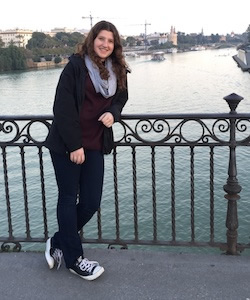Continuing my pattern of writing about topics that would be inappropriate for dinnertime conversation, I will now transition from my discussion of Spanish politics in my
last blog post to my present attempt to unpack the modern day relationship between Spain and organized religion.
I’ve been surprised by the general lack of outward religious expression by individuals in Sevilla (Seville), especially since the city is famous for its elaborate processions and rituals that occur in the week leading up to Easter, known as Semana Santa (Holy Week). Sevilla is home to the largest Gothic cathedral in the world, a tremendous structure that sprawls out from the city center and whose impressive tower, known as La Giralda, is visible from most vantage points in the city. Religious iconography and the vestiges of a history molded by both Christian and Muslim leaders are everywhere, from the decoration on the sides of buildings to the pronunciation of certain words and phrases. However, the majority of Sevillanos I’ve questioned directly about religion have expressed a great deal of apathy towards their religious backgrounds, noting frequently “I’m Catholic, but I’m not religious.” The general consensus seems to be that for most Spaniards here in Sevilla, religious inclination is something that changes with the seasons, the mood in the city, and even the weather. It is not necessarily regarded as a trivial interest; it’s just not seen as a major aspect of everyday life, especially for the younger Sevillanos I’ve met in my classes at the local university.
This apparent disconnect between the collective understanding of religion in this city and the private thoughts of the individuals who inhabit it has been immensely fascinating to witness as an outsider, both in a geographic and theological sense. As an American Jew of Ashkenazi descent, my religious customs and cultural touchstones are far removed from the Spanish experience, yet I have not felt alienated by the general population. In fact, many people have delighted in questioning me about Jewish holidays and traditions. Conversely, I’ve found it more difficult to gain acceptance into the Jewish community here in Sevilla than anything else, largely due to the fact that there is only one synagogue left in the entire city. This synagogue is where the Orthodox community congregates, and the rest of the Jews in Sevilla have subsequently formed a quasi-underground network without an established place of worship.
Compare this esoteric experience of the Jewish minority to that of the Catholic majority in a place where enormous churches remain largely vacant, and you’ll begin to see why I’ve become fascinated by the varied manifestations of religious devotion in Sevilla. It is as if those people who see their religion all around them feel little need to identify closely with the teachings of the religion on a daily basis, while those individuals who were historically pushed out of Spanish society (quite literally) have doubled down on their faith, going so far as to create an entire world for themselves out of public view. I hope that over the course of the rest of my semester here, I have an opportunity to get a glimpse into that hidden world to see if the individuals who compose it are more openly religious in their private space than the majority of their Catholic counterparts.

